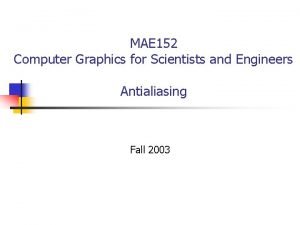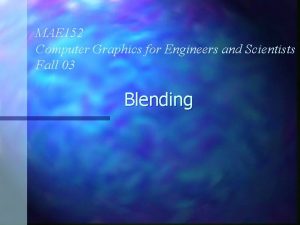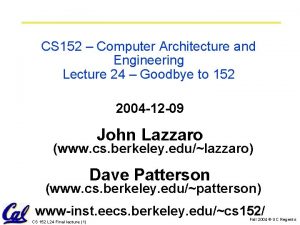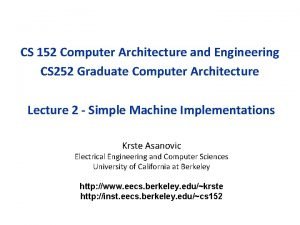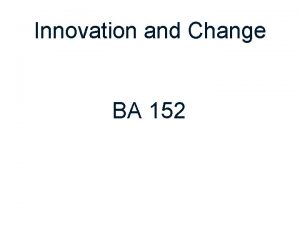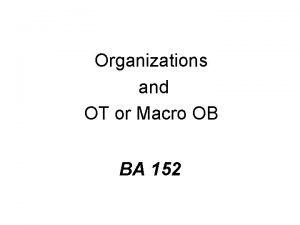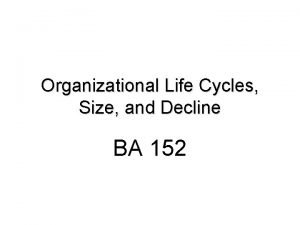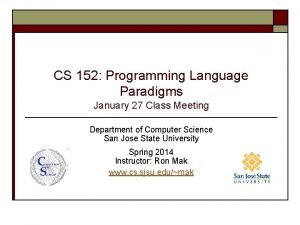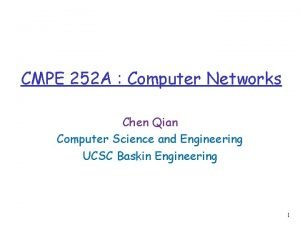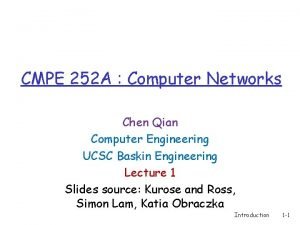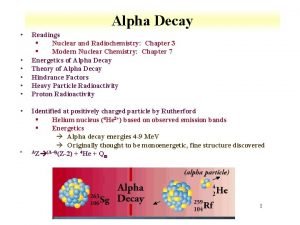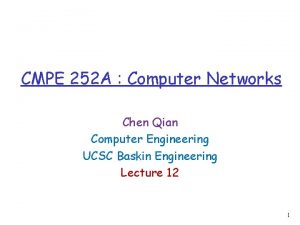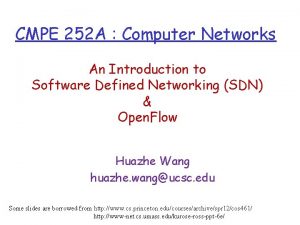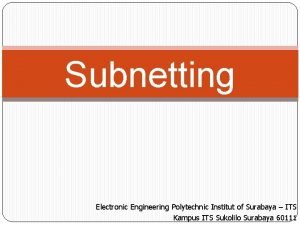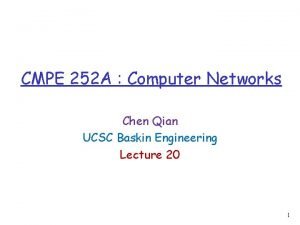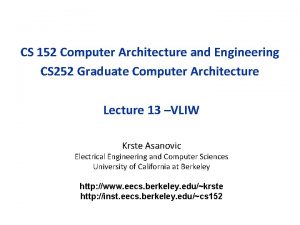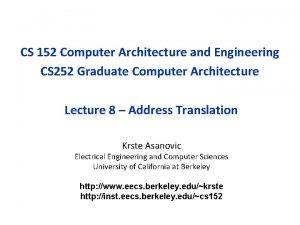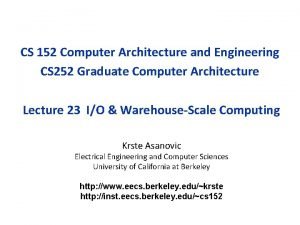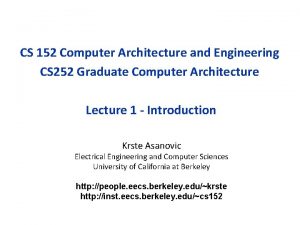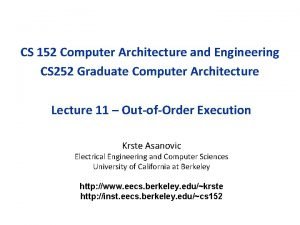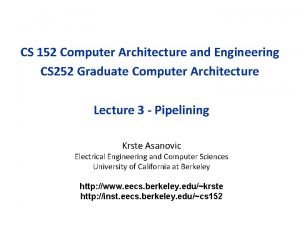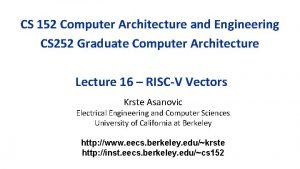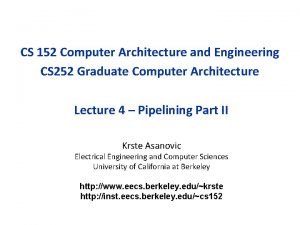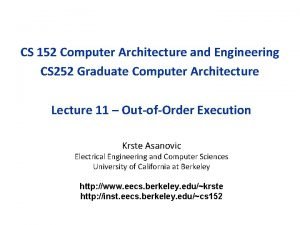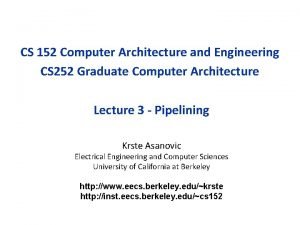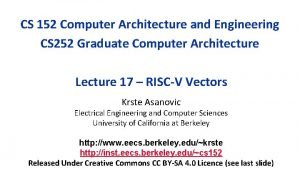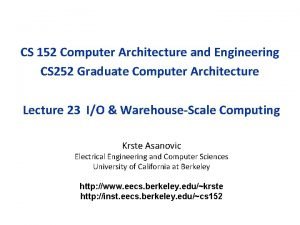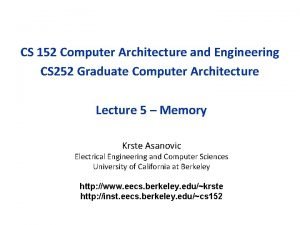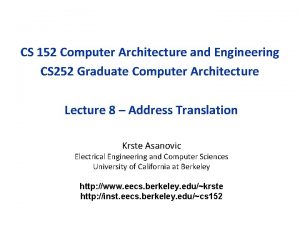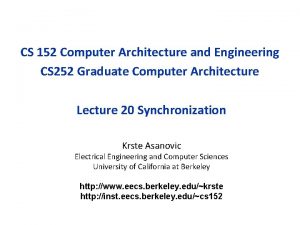CS 152 Computer Architecture and Engineering CS 252












![Simple vector-vector add code example # # for(i=0; i<N; i++) A[i] = B[i]+C[i]; loop: Simple vector-vector add code example # # for(i=0; i<N; i++) A[i] = B[i]+C[i]; loop:](https://slidetodoc.com/presentation_image_h2/4d181cc86704f1ce562eabc439fbe7f7/image-13.jpg)















![[© IBM] 29 [© IBM] 29](https://slidetodoc.com/presentation_image_h2/4d181cc86704f1ce562eabc439fbe7f7/image-29.jpg)







![MC 68060 Dynamic ALU Scheduling EA x 2+24 MEM EA ALU x 1+M[x 2+24] MC 68060 Dynamic ALU Scheduling EA x 2+24 MEM EA ALU x 1+M[x 2+24]](https://slidetodoc.com/presentation_image_h2/4d181cc86704f1ce562eabc439fbe7f7/image-37.jpg)

- Slides: 38

CS 152 Computer Architecture and Engineering CS 252 Graduate Computer Architecture Lecture 4 – Pipelining Part II Krste Asanovic Electrical Engineering and Computer Sciences University of California at Berkeley http: //www. eecs. berkeley. edu/~krste http: //inst. eecs. berkeley. edu/~cs 152

Last Time in Lecture 3 § Iron law of performance: – time/program = insts/program * cycles/inst * time/cycle § Classic 5 -stage RISC pipeline § Structural, data, and control hazards § Structural hazards handled with interlock or more hardware § Data hazards include RAW, WAR, WAW – Handle data hazards with interlock, bypass, or speculation § Control hazards (branches, interrupts) most difficult as change which is next instruction – Branch prediction commonly used § Precise traps: stop cleanly on one instruction, all previous instructions completed, no following instructions have changed architectural state 2

Recap: Trap: altering the normal flow of control Ii-1 program HI 1 Ii HI 2 Ii+1 HIn trap handler An external or internal event that needs to be processed by another (system) program. The event is usually unexpected or rare from program’s point of view. 3

Recap: Trap Handler § Saves EPC before enabling interrupts to allow nested interrupts – need an instruction to move EPC into GPRs – need a way to mask further interrupts at least until EPC can be saved § Needs to read a status register that indicates the cause of the trap § Uses a special indirect jump instruction ERET (return-from-environment) which – enables interrupts – restores the processor to the user mode – restores hardware status and control state 4

Recap: Synchronous Trap § A synchronous trap is caused by an exception on a particular instruction § In general, the instruction cannot be completed and needs to be restarted after the exception has been handled – requires undoing the effect of one or more partially executed instructions § In the case of a system call trap, the instruction is considered to have been completed – a special jump instruction involving a change to a privileged mode 5

Recap: Exception Handling 5 -Stage Pipeline PC Inst. Mem PC address Exception D Decode Illegal Opcode E + M Overflow Data Mem W Data address Exceptions Asynchronous Interrupts § How to handle multiple simultaneous exceptions in different pipeline stages? § How and where to handle external asynchronous interrupts? 6

Recap: Exception Handling 5 -Stage Pipeline Commit Point Select Handler PC E Illegal Opcode + M Overflow Data Mem Data address Exceptions Exc D Exc E Exc M PC Kill F D PC E PC M Asynchronous Stage Kill D Stage Kill E Stage W Cause PC address Exception D Decode EPC PC Inst. Mem Interrupts Kill Writeback 7

Recap: Exception Handling 5 -Stage Pipeline § Hold exception flags in pipeline until commit point (M stage) § Exceptions in earlier pipe stages override later exceptions for a given instruction § Inject external interrupts at commit point (override others) § If trap at commit: update Cause and EPC registers, kill all stages, inject handler PC into fetch stage 8

Recap: Speculating on Exceptions § Prediction mechanism – Exceptions are rare, so simply predicting no exceptions is very accurate! § Check prediction mechanism – Exceptions detected at end of instruction execution pipeline, special hardware for various exception types § Recovery mechanism – Only write architectural state at commit point, so can throw away partially executed instructions after exception – Launch exception handler after flushing pipeline § Bypassing allows use of uncommitted instruction results by following instructions 9

Deeper Pipelines: MIPS R 4000 Commit Point Direct-mapped I$ allows use of instruction before tag check complete Figure C. 36 The eight-stage pipeline structure of the R 4000 uses pipelined instruction and data caches. The pipe stages are labeled and their detailed function is described in the text. The vertical dashed lines represent the stage boundaries as well as the location of pipeline latches. The instruction is actually available at the end of IS, but the tag check is done in RF, while the registers are fetched. Thus, we show the instruction memory as operating through RF. The TC stage is needed for data memory access, because we cannot write the data into the register until we know whether the cache access was a hit or not. © 2018 Elsevier Inc. All rights reserved. 10

R 4000 Load-Use Delay Direct-mapped D$ allows use of data before tag check complete Figure C. 37 The structure of the R 4000 integer pipeline leads to a x 1 load delay. A x 1 delay is possible because the data value is available at the end of DS and can be bypassed. If the tag check in TC indicates a miss, the pipeline is backed up a cycle, when the correct data are available. © 2018 Elsevier Inc. All rights reserved. 11

R 4000 Branches Figure C. 39 The basic branch delay is three cycles, because the condition evaluation is performed during EX. © 2018 Elsevier Inc. All rights reserved. 12
![Simple vectorvector add code example fori0 iN i Ai BiCi loop Simple vector-vector add code example # # for(i=0; i<N; i++) A[i] = B[i]+C[i]; loop:](https://slidetodoc.com/presentation_image_h2/4d181cc86704f1ce562eabc439fbe7f7/image-13.jpg)
Simple vector-vector add code example # # for(i=0; i<N; i++) A[i] = B[i]+C[i]; loop: fld f 0, 0(x 2) // x 2 points to B fld f 1, 0(x 3) // x 3 points to C fadd. d f 2, f 0, f 1 fsd f 2, 0(x 1) // x 1 points to A addi x 1, 8 // Bump pointer addi x 2, 8 // Bump pointer addi x 3, 8 // Bump pointer bne x 1, x 4, loop // x 4 holds end 13

Simple Pipeline Scheduling Can reschedule code to try to reduce pipeline hazards loop: fld f 0, 0(x 2) // x 2 points to B fld f 1, 0(x 3) // x 3 points to C addi x 3, 8 // Bump pointer addi x 2, 8 // Bump pointer fadd. d f 2, f 0, f 1 addi x 1, 8 // Bump pointer fsd f 2, -8(x 1) // x 1 points to A bne x 1, x 4, loop // x 4 holds end Long latency loads and floating-point operations limit parallelism within a single loop iteration 14

One way to reduce hazards: Loop Unrolling Can unroll to expose more parallelism, reduce dynamic instruction count loop: fld f 0, 0(x 2) // x 2 points to B fld f 1, 0(x 3) // x 3 points to C fld f 10, 8(x 2) fld f 11, 8(x 3) addi x 3, 16 // Bump pointer addi x 2, 16 // Bump pointer fadd. d f 2, f 0, f 1 fadd. d f 12, f 10, f 11 addi x 1, 16 // Bump pointer fsd f 2, -16(x 1) // x 1 points to A fsd f 12, -8(x 1) bne x 1, x 4, loop // x 4 holds end § § Unrolling limited by number of architectural registers Unrolling increases instruction cache footprint More complex code generation for compiler, has to understand pointers Can also software pipeline, but has similar concerns 15

Alternative Approach: Decoupling (lookahead, runahead) in µarchitecture Can separate control and memory address operations from data computations: loop: fld f 0, 0(x 2) // x 2 points to B fld f 1, 0(x 3) // x 3 points to C fadd. d f 2, f 0, f 1 fsd f 2, 0(x 1) // x 1 points to A addi x 1, 8 // Bump pointer addi x 2, 8 // Bump pointer addi x 3, 8 // Bump pointer bne x 1, x 4, loop // x 4 holds end The control and address operations do not depend on the data computations, so can be computed early relative to the data computations, which can be delayed until later. CS 252 16

Simple Decoupled Machine Integer Pipeline F D X MW {Load Data Writeback µOp} {Compute µOp} µOp Queue {Store Data Read µOp} Load Data Queue R X 1 X 2 X 3 W Floating-Point Pipeline Check Load Address Store Address Queue CS 252 Load Data Store Data Queue 17

Decoupled Execution fld f 0 fld f 1 fadd. d fsd f 2 addi x 1 addi x 2 addi x 3 bne fld f 0 fld f 1 fadd. d fsd f 2 … CS 252 Send load to memory, queue up write to f 0 Send load to memory, queue up write to f 1 Queue up fadd. d Queue up store address, wait for store data Bump pointer Check load address. Many writes to f 0 Bump pointer against queued can be in queue at same time Bump pointer pending store addresses Take branch Send load to memory, queue up write to f 0 Send load to memory, queue up write to f 1 Queue up fadd. d Queue up store address, wait for store data 18

Simple Decoupled Machine Integer Pipeline F D X MW {Load Data Writeback µOp} {Compute µOp} µOp Queue {Store Data Read µOp} Load Data Queue R X 1 X 2 X 3 W Floating-Point Pipeline Check Load Address Store Address Queue CS 252 Load Data Store Data Queue 19

CS 152 Administrivia § PS 1 is due at start of class on Monday Feb 10 § Lab 1 due at start of class Wednesday Feb 19 20

CS 252 Administrivia § Project proposals due Wed Feb 26 th § Use Krste’s office hours Wed 8: 30 -9: 30 am to get feedback on ideas § Readings discussion will be Wednesdays 1 -2 pm, room TBD CS 252 21

IBM 7030 “Stretch” (1954 -1961) § Original goal was to use new transistor technology to give 100 x performance of tube-based IBM 704. § Design based around 4 stages of “lookahead” pipelining § More than just pipelining, a simple form of decoupled execution with indexing and branch operations performed © IBM speculatively ahead of data operations § Also had a simple store buffer • Very complex design for the time, difficult to explain to users performance of pipelined machine • When finally delivered in 1961, was benchmarked at only 30 x 704 and embarrassed IBM, causing price to drop from $13. 5 M to $7. 8 M, and withdrawal after initial deliveries • But technologies lived on in later IBM computers, 360 and POWER CS 252 22

Supercomputers Definitions of a supercomputer: § Fastest machine in world at given task § A device to turn a compute-bound problem into an I/O bound problem § Any machine costing $30 M+ § Any machine designed by Seymour Cray § CDC 6600 (Cray, 1964) regarded as first supercomputer 23

CDC 6600 Seymour Cray, 1964 § A fast pipelined machine with 60 -bit words – 128 Kword main memory capacity, 32 banks § Ten functional units (parallel, unpipelined) – Floating Point: adder, 2 multipliers, divider – Integer: adder, 2 incrementers, . . . § Hardwired control (no microcoding) § Scoreboard for dynamic scheduling of instructions § Ten Peripheral Processors for Input/Output – a fast multi-threaded 12 -bit integer ALU § Very fast clock, 10 MHz (FP add in 4 clocks) § >400, 000 transistors, 750 sq. ft. , 5 tons, 150 k. W, novel freon-based technology for cooling § Fastest machine in world for 5 years (until 7600) – over 100 sold ($7 -10 M each) 3/10/2009 24

CDC 6600: A Load/Store Architecture • Separate instructions to manipulate three types of reg. • 8 x 60 -bit data registers (X) • 8 x 18 -bit address registers (A) • 8 x 18 -bit index registers (B) • All arithmetic and logic instructions are register-to-register 6 3 3 opcode i j 3 Ri Rj op Rk k • Only Load and Store instructions refer to memory! 6 opcode 3 3 i j 18 disp Ri M[Rj + disp] Touching address registers 1 to 5 initiates a load 6 to 7 initiates a store - very useful for vector operations 25

CDC 6600: Datapath Operand Regs 8 x 60 -bit operand 10 Functional Units result Central Memory Address Regs 128 K words, 8 x 18 -bit 32 banks, 1µs cycle operand Index Regs 8 x 18 -bit IR Inst. Stack 8 x 60 -bit addr result addr 26

CDC 6600: Vector Addition B 0 ← - n loop: JZE B 0, exit A 0 ← B 0 + a 0 A 1 ← B 0 + b 0 X 6 ← X 0 + X 1 A 6 ← B 0 + c 0 B 0 ← B 0 + 1 jump loop load X 0 load X 1 store X 6 Ai = address register Bi = index register Xi = data register 27

CDC 6600 ISA designed to simplify high-performance implementation § Use of three-address, register-register ALU instructions simplifies pipelined implementation – Only 3 -bit register-specifier fields checked for dependencies – No implicit dependencies between inputs and outputs § Decoupling setting of address register (Ar) from retrieving value from data register (Xr) simplifies providing multiple outstanding memory accesses – Address update instruction also issues implicit memory operation – Software can schedule load of address register before use of value – Can interleave independent instructions inbetween § CDC 6600 has multiple parallel unpipelined functional units – E. g. , 2 separate multipliers § Follow-on machine CDC 7600 used pipelined functional units – Foreshadows later RISC designs 28
![IBM 29 [© IBM] 29](https://slidetodoc.com/presentation_image_h2/4d181cc86704f1ce562eabc439fbe7f7/image-29.jpg)
[© IBM] 29

IBM Memo on CDC 6600 Thomas Watson Jr. , IBM CEO, August 1963: “Last week, Control Data. . . announced the 6600 system. I understand that in the laboratory developing the system there are only 34 people including the janitor. Of these, 14 are engineers and 4 are programmers. . . Contrasting this modest effort with our vast development activities, I fail to understand why we have lost our industry leadership position by letting someone else offer the world's most powerful computer. ” To which Cray replied: “It seems like Mr. Watson has answered his own question. ” 30

Computer Architecture Terminology Latency (in seconds or cycles): Time taken for a single operation from start to finish (initiation to useable result) Bandwidth (in operations/second or operations/cycle): Rate of which operations can be performed Occupancy (in seconds or cycles): Time during which the unit is blocked on an operation (structural hazard) Note, for a single functional unit: § Occupancy can be much less than latency (how? ) § Occupancy can be greater than latency (how? ) § Bandwidth can be greater than 1/latency (how? ) § Bandwidth can be less than 1/latency (how? ) 31

Issues in Complex Pipeline Control • Structural conflicts at the execution stage if some FPU or memory unit is not pipelined and takes more than one cycle • Structural conflicts at the write-back stage due to variable latencies of different functional units • Out-of-order write hazards due to variable latencies of different functional units • How to handle exceptions? Mem ALU IF ID WB Issue GPRs Fadd Fmul Fdiv 32

CDC 6600 Scoreboard § Instructions dispatched in-order to functional units provided no structural hazard or WAW – Stall on structural hazard, no functional units available – Only one pending write to any register § Instructions wait for input operands (RAW hazards) before execution – Can execute out-of-order § Instructions wait for output register to be read by preceding instructions (WAR) – Result held in functional unit until register free 33

More Complex In-Order Pipeline Inst. PC Mem D Decode § Delay writeback so all operations have same latency to W stage – Write ports never oversubscribed (one inst. in & one inst. out every cycle) – Stall pipeline on long latency operations, e. g. , divides, cache misses – Handle exceptions in-order at commit point GPRs FPRs How to prevent increased writeback latency from slowing down single cycle integer operations? Bypassing X 1 + Data X 2 Mem X 3 W X 2 FAdd X 3 W X 2 FMul X 3 Unpipelined divider FDiv X 2 X 3 Commit Point 34

In-Order Superscalar Pipeline PC Inst. Mem 2 Dual D Decode GPRs X 1 + X 2 FPRs X 1 § Fetch two instructions per cycle; issue both simultaneously if one is integer/memory and other is floating point § Inexpensive way of increasing throughput, examples include Alpha 21064 (1992) & MIPS R 5000 series (1996) § Same idea can be extended to wider issue by duplicating functional units (e. g. 4 -issue Ultra. SPARC & Alpha 21164) but regfile ports and bypassing costs grow quickly Data Mem X 3 W X 2 FAdd X 3 W X 2 FMul X 3 Unpipelined divider FDiv X 2 X 3 Commit Point 35

In-Order Pipeline with two ALU stages Address calculate before memory access Integer ALU after memory access [ © Motorola 1994 ] 36
![MC 68060 Dynamic ALU Scheduling EA x 224 MEM EA ALU x 1Mx 224 MC 68060 Dynamic ALU Scheduling EA x 2+24 MEM EA ALU x 1+M[x 2+24]](https://slidetodoc.com/presentation_image_h2/4d181cc86704f1ce562eabc439fbe7f7/image-37.jpg)
MC 68060 Dynamic ALU Scheduling EA x 2+24 MEM EA ALU x 1+M[x 2+24] add x 1, 24(x 2) MEM add x 3, x 1, x 6 EA x 2+12 ALU x 1+x 6 MEM EA x 5+16 addi x 5, x 2, 12 ALU MEM EA x 3+16 lw x 4, 16(x 5) ALU MEM ALU lw x 8, 16(x 3) Common trick used in modern in-order RISC pipeline designs, even without reg -mem operations Not a real RISC-V instruction! Using RISC-V style assembly code for MC 68060 37

Acknowledgements § This course is partly inspired by previous MIT 6. 823 and Berkeley CS 252 computer architecture courses created by my collaborators and colleagues: – – – Arvind (MIT) Joel Emer (Intel/MIT) James Hoe (CMU) John Kubiatowicz (UCB) David Patterson (UCB) 38
 Organization and architecture difference
Organization and architecture difference Buses in computer architecture
Buses in computer architecture System architecture example
System architecture example Basic computer organization and design
Basic computer organization and design Un r 152
Un r 152 152 регмон
152 регмон Przedszkole 152 łódź
Przedszkole 152 łódź![Law society of tasmania v richardson [2003] tassc 9 Law society of tasmania v richardson [2003] tassc 9](data:image/svg+xml,%3Csvg%20xmlns=%22http://www.w3.org/2000/svg%22%20viewBox=%220%200%20200%20200%22%3E%3C/svg%3E) Law society of tasmania v richardson [2003] tassc 9
Law society of tasmania v richardson [2003] tassc 9 Rounding numbers to the nearest hundred thousand
Rounding numbers to the nearest hundred thousand Mae 152
Mae 152 Mae 152
Mae 152 Cs 152 stanford
Cs 152 stanford Cs 152 berkeley
Cs 152 berkeley Ba 152
Ba 152 Ece 152
Ece 152 Ba 152
Ba 152 Econ 152
Econ 152 Which layer in the osi model covers http, ftp, and rdc?
Which layer in the osi model covers http, ftp, and rdc? Ba 152
Ba 152 Macroob
Macroob Organizational atrophy
Organizational atrophy Plasa
Plasa Econ 152
Econ 152 Cs152 sjsu
Cs152 sjsu Gfi 152
Gfi 152 Acordada 961/15
Acordada 961/15 Cmpe 252
Cmpe 252 Qian chen ucsc
Qian chen ucsc Cf-252 decay scheme
Cf-252 decay scheme Simplyfying radicals
Simplyfying radicals Bone marrow hops 252
Bone marrow hops 252 Cmpe 252
Cmpe 252 Cmpe 252
Cmpe 252 252 binary
252 binary 252 nomreli mekteb
252 nomreli mekteb 252 netmask
252 netmask 252 netmask
252 netmask 252 basics
252 basics Chen qian ucsc
Chen qian ucsc




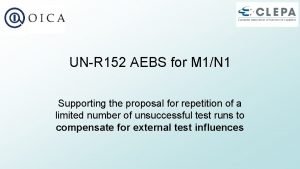
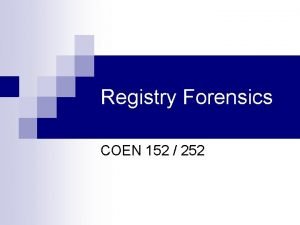

![Law society of tasmania v richardson [2003] tassc 9 Law society of tasmania v richardson [2003] tassc 9](https://slidetodoc.com/wp-content/uploads/2020/10/1024173_0ab07c7fa5fe15bbad1bb1a43f32eeb0-300x225.jpg)

